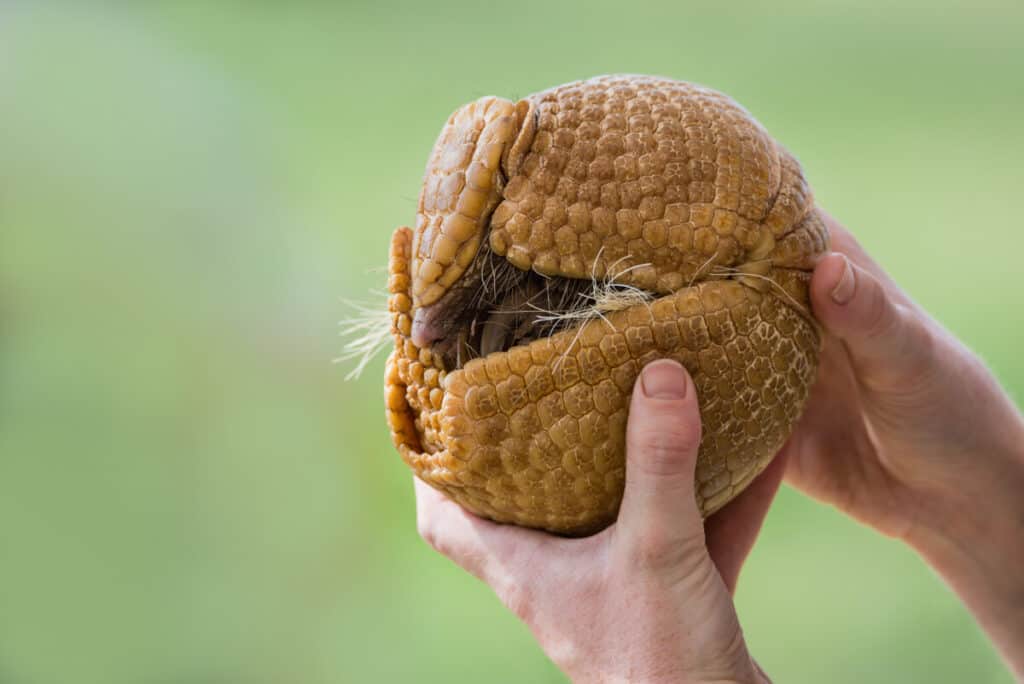Armadillos are small mammals native to the Americas. They have a distinct armor-like shell covering their back, head and sides, which is made up of bone plates covered in horn or leathery skin. While many people know about these unique animals, few understand their behavior.
This article will explore armadillo behavior, including feeding habits and communication methods. Armadillos live solitary lives with little interaction between individuals unless during mating season or when caring for young. Though there is still much that needs to be studied regarding armadillo behavior, research has been conducted on various aspects of it such as diet preferences, activity levels and responses to environmental stimuli.
Each species varies slightly in terms of its behaviors and habitats but they share some general characteristics concerning how they interact with each other and their environment.

Diet And Feeding Habits
Armadillos are omnivorous and have a varied diet of insects, small vertebrates such as lizards, birds and eggs, fruits, roots and tubers.
Their foraging behavior is mainly nocturnal, although they can also be active during the day when resources are abundant. Armadillos rely heavily on their sense of smell to find food, using their long snout to sniff out prey items and underground bulbs or tubers.
Burrowing habits vary among species; some burrow extensively while others only occasionally dig shallow depressions in which to rest or search for food. While most armadillo species prefer dry soils that facilitate excavation, there are exceptions with some species being aquatic or semi-aquatic.
The purpose of these burrows varies from sheltering themselves from extreme temperatures to escaping predation pressure. In addition to providing protection from predators and harsh weather conditions, burrows also provide nesting sites for female armadillos to raise young.
Therefore, understanding armadillo feeding habits and burrowing behaviors can help us comprehend how these animals interact with their environment.
Social Interaction And Communication
The social interaction and communication of armadillos is a fascinating field of study. In the wild, they display an impressive range of behaviors that are essential to their survival in the environment. From hibernation cycles to establishing territories and finding shelter needs, these animals must be able to communicate effectively with one another.
To begin with, armadillos reduce social contact during periods when food availability is low or temperatures drop below freezing, entering into long bouts of hibernation during which they remain inactive for up to six months at a time. During this period, they become almost comatose-like as their body temperature drops and metabolic rate slows significantly in order to conserve energy.
They also engage in territorial behavior by marking areas with urine scent glands located on their abdomen; this allows them to defend resources such as food and shelter from other members of their species who may intrude upon the area. Furthermore, armadillos have adapted well to living around humans, often taking refuge beneath porches or decks and even burrowing underneath sheds or outbuildings for protection from predators.
Their diet consists mainly of insects but can include fruits, small vertebrates like frogs and lizards, bird eggs, carrion and plant material depending on what’s available in the surrounding environment.
Overall, armadillo social interaction involves various forms of communication through different activities including hibernation cycles, scent marking territories and seeking out shelter needs. Through careful observation it becomes clear how important social interaction is for these animals’ day-to-day lives ensuring their continued success in the wild.
Activity Levels
Armadillos are known to have distinct activity levels, engaging in most of their behaviors during the night. Their nocturnal habits are largely attributed to their burrow creation and tunneling activities that take place under the cover of darkness.
Armadillos will spend much of the day sleeping within these underground structures, only emerging at dusk for foraging, mating or other forms of social interaction. During this period, they demonstrate a heightened level of alertness as they search for food sources such as insects and fruits.
The armadillo is also capable of active movement throughout its habitat when searching for prey or defending itself from potential predators. This behavior is typically seen around dawn and twilight periods where light conditions provide some degree of protection from natural enemies.
The animal may even seek out open areas during daylight hours if it feels threatened by the presence of another armadillo or larger animals nearby. In any case, overall activity levels decrease significantly after midnight with few sightings recorded until morning approaches again.
Responses To Environmental Stimuli
Studies of armadillo behavior show that they are highly responsive to environmental stimuli. Armadillos construct burrows with complex, intricate designs in order to regulate their body temperature and protect themselves from predators. Burrow construction is an essential part of the armadillo’s daily life; it often begins soon after dawn and can take several hours to complete:
- The first step involves digging a shallow depression in the ground using its powerful forelimbs and claws.
- Then, the armadillo excavates a series of tunnels by pushing soil away with its snout and hind legs.
- Finally, the animal packs loose dirt around the entrance for insulation against cold temperatures or hot weather conditions.
Temperature regulation plays a critical role in these behaviors as well; when outside temperatures reach extreme levels, armadillos will seek shelter within their burrows to maintain a steady body heat and avoid predation risks.
Thus, through careful manipulation of their environment, they maximize their chances of survival while also protecting themselves from harm. To ensure maximum protection against extreme temperatures, some species may even line the walls of their burrows with grasses or leaves for further insulation purposes.
Mating Habits
Armadillos, like other mammals, have distinct mating habits. During the breeding season, which typically occurs between December and April depending on the species of armadillo, male armadillos will forage for females in both terrestrial and subterranean habitats. Typically, males will search by smell or sound to locate a receptive female. When found, they are often chased until copulation is completed.
Mating rituals vary among different species of armadillos; however most have similar behavior patterns when it comes to reproductive activities. For instance, many species exhibit polygyny during their breeding cycles where one dominant male mates with multiple females at once. Additionally some species also display communal nesting behaviors where several adult males mate with one female collectively while defending her from other potential suitors using aggression and intimidation tactics.
| Species | Mating Rituals | Breeding Cycles |
|---|---|---|
| Nine-banded Armadillo | Polygyny & Chasing | Dec – Apr |
| Greater Fairy Armadillo | Communal Nesting | Nov – Mar |
| Pink fairy Armadillo | Solitary | Jan – May |

Parenting And Care For Young
Armadillos are solitary animals, but during the breeding season males and females will come together in pairs.
Armadillo parenting behaviors vary by species, although most young armadillos remain with their parents for several months following birth.
The mother typically builds a nest of vegetation or soil prior to giving birth and provides food for her offspring until they can fend for themselves.
Burrowing behavior is also an important part of the nesting habits of some armadillo species; these burrows may be used as shelters from predators or extreme weather conditions.
In addition, adult armadillos often share burrows with groups of juveniles that have not yet become independent and must still rely on parental care.
This mutualistic relationship between adults and juveniles helps ensure the survival of both generations.
Through this practice, juvenile armadillos develop skills that allow them to eventually live independently without relying solely on their parents’ protection or resources.
Conclusion
The research on armadillo behavior is revealing.
Armadillos feed primarily on insects and other invertebrates, though they will also scavenge for plant material when necessary.
They are social creatures that communicate through vocalizations and physical contact, remaining active during the day as well as parts of the night.
In response to environmental stimuli such as threats or new resources, they may become aggressive or curious respectively.
Mating involves elaborate courtship displays before females give birth to a single young after a gestation period of 4 months.
The mother takes care of her offspring until it reaches independence at approximately 8 months old.
This information gives researchers an understanding of these animals’ lifestyles in their natural environment and helps us better protect them from human-induced threats.

